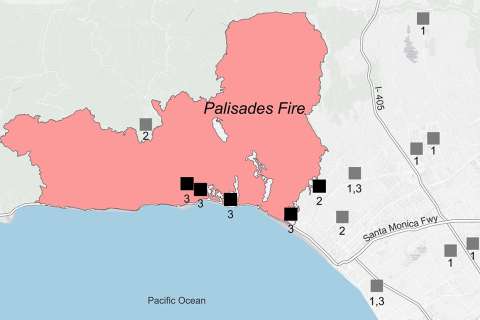A new clinical and preclinical study from UCLA Jonsson Comprehensive Cancer Center identifies the DNA roots of resistance to targeted cancer therapy, providing a possible strategy to address a vexing issue in cancer therapeutics. Results are published online ahead of print in Cancer Discovery, a journal of the American Association for Cancer Research.
“We are taking a fresh approach to combat ‘acquired therapy resistance’ – the ability of cancers to escape targeted treatments by undergoing molecular evolution. Intensive research has focused on treatment of cancers that have relapsed, seeking to intervene after the tumor cells have become more complicated and stronger. We thought that preventing, rather than trying to reverse resistance after the cancer has become more aggressive, may improve our patients’ odds of survival,” said co-senior author Dr. Roger Lo, a UCLA Jonsson Comprehensive Cancer Center researcher and a professor of medicine and molecular and medical pharmacology at the David Geffen School of Medicine at UCLA.
To understand how the cancer genome changes immediately after the initiation of targeted therapy – potentially generating new genetic variants capable of escaping the therapy – the researchers focused on metastatic cutaneous melanoma. This aggressive skin cancer had no effective treatment until the recent development of a targeted therapy for patients whose cancers harbor a BRAF gene mutation – found in about half of metastatic melanoma patients and in patients with many other types of common and highly lethal cancers.
“We hope that by blocking the means for melanoma to generate genetic diversity, we may prevent the myriad of ways the cancer escapes targeted therapy,” Lo said.

Through analysis of tumor biopsies taken from patients before targeted therapy and then at the time of clinical relapse, the team found that the melanoma genome can undergo extensive ‘shattering and re-stitching’ in response to targeted therapy – in a process called chromothripsis. Small amounts of chromosomal DNA can drop out of the chromosome and become re-stitched to become ‘circular extrachromosomal DNAs,’ or ecDNAs. The cancer cells can generate and retain many copies of these ecDNAs – 50 to 100 copies in some cases – which amplify key genes that drive therapy resistance. The ecDNAs also can reintegrate back into chromosomes, becoming a stable source of gene amplification.
“We analyzed how the re-stitching of shattered genomic DNA occurred in resistant melanoma and discovered that a protein called DNA-PK may be particularly important,” said Prashanthi Dharanipragada, a post-doctoral fellow on the Lo team and a co-lead author with post-doctoral fellow Xiao Zhang.
“We tested a new combination approach to block genomic instability and prevent acquired resistance in model cell lines and patients’ tumor cells implanted in mice,” said Gatien Moriceau, assistant adjunct professor of medicine and co-senior author. “We believe it may be possible to apply this approach to multiple subtypes of melanoma and several other types of aggressive cancers such as pancreatic and lung cancers.”
Based on these preclinical findings, Lo and co-author Stergios Moschos, a clinical professor and melanoma researcher at the University of North Carolina at Chapel Hill, are designing a clinical trial for patients with subtypes of melanoma.
Article: Blocking Genomic Instability Prevents Acquired Resistance to MAPK Inhibitor Therapy in Melanoma DOI: 10.1158/2159-8290.CD-22-0787
Additional authors include: Sixue Liu, Shirley H. Lomeli, Aayoung Hong, Yan Wang, Zhentao Yang, Kara Z. Lo, Agustin Vega-Crespo, and Antoni Ribas of the David Geffen School of Medicine at UCLA.
This research was supported by grants (to R.S.L.) from the National Institutes of Health (NIH) (1R01CA176111A1, 1R21CA215910-01, R21CA255837-01, 1P01CA168585), the Melanoma Research Alliance (MRA) (Team Science Awards 2020 and 2022), and the V Foundation for Cancer Research (Translational Award). Additional funding was provided by the NIH 1P01CA168585 (to G.M.), MRA Dermatology Fellows Award (P.D., S.L. and Z.Y.), MRA Young Investigator Award (G.M.), Jonsson Comprehensive Cancer Center (JCCC) Postdoctoral Seed Grant (to Z.Y.), JCCC Postdoctoral Fellowships (to P.D., X.Z., S.L. and Z.Y.), and the NIH T32CA009120 Tumor Immunology Postdoctoral Fellowship (to A.H.). S.L. is the recipient of a Career Development Award from the Melanoma Research Foundation. Additional support came from Mary Tanner and Maurizio Grimaldi (R.S.L.), the Ressler Family Foundation (R.S.L.), and the University Cancer Research Fund (Lineberger Comprehensive Cancer Center, the University of North Carolina at Chapel Hill, UNC-CH).
Disclosures R.S. Lo reports research support from Merck and OncoSec, clinical trial support from Pfizer and BMS, and invention on U.S. Patent Application Serial No.: 63/268,028. S.J. Moschos reports research support from Merck, Amgen, SYNDAX and serves as consultant for EMD Serono and iTeos Therapeutics. A.R. reports honoraria from Amgen, Bristol-Myers Squibb, and Merck as well as service on the scientific advisory boards of and ownership of stocks in Advaxis, Appia, Apricity, Arcus, Compugen, CytomX, Highlight, ImaginAb, ImmPact, ImmuneSensor, Inspirna, Isoplexis, Kite-Gilead, Lutris, MapKure, Merus, PACT, Pluto, RAPT, Synthekine and Tango. A.R. reports research funding from Agilent and Bristol-Myers Squibb through Stand Up to Cancer (SU2C) and patent royalties from Arsenal Bio. No disclosures were reported by the other authors.




